
 |
|
|
#1 |
|
Member
Join Date: Nov 2004
Location: USA
Posts: 1,725
|
Some of you may have seen this in March at the Timonium show, when I took delivery of it from Battara (Jose).
I purchased this and another sword from Artzi at the 2004 Timonium Antique Arms and Armor show, and shortly thereafter shipped it to Jose for scabbard and handle restoration. I picked up a short knife that matched it pretty closely from RhysMichael, and Jose restored it as well. This sword appears in Tony Tirri's book Islamic Weapons, and was in pretty rough shape when I got it. Unfortunately, I have no good pre-restoration shots, other than the one in Tony's book. It cleaned up nicely.  Overall shot: 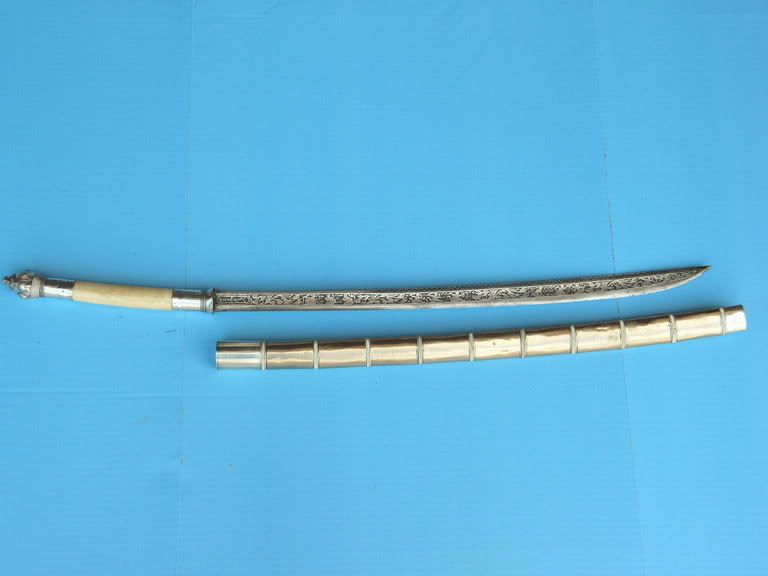 The handle was coming apart at the ivory/ferrule junction. Jose definitely tightened things up. 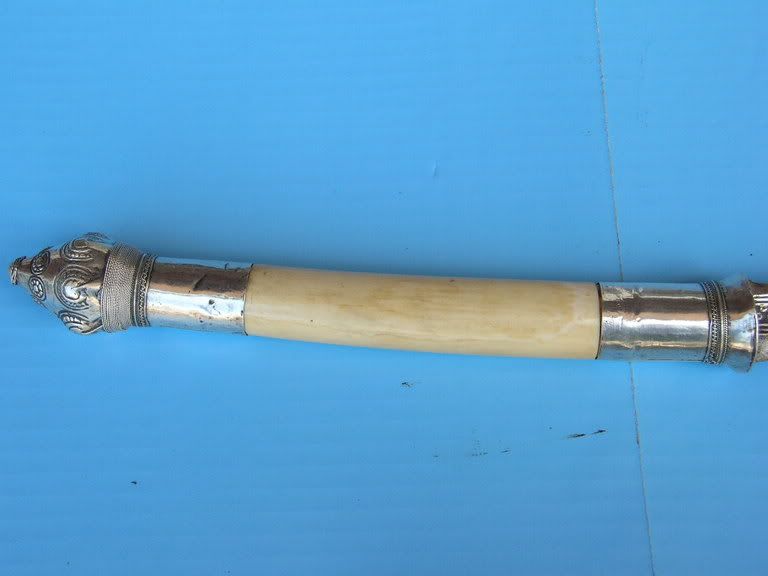 The twisted silver wire covers an old lead repair that looked like the pommel had been completely decapitated at some point. 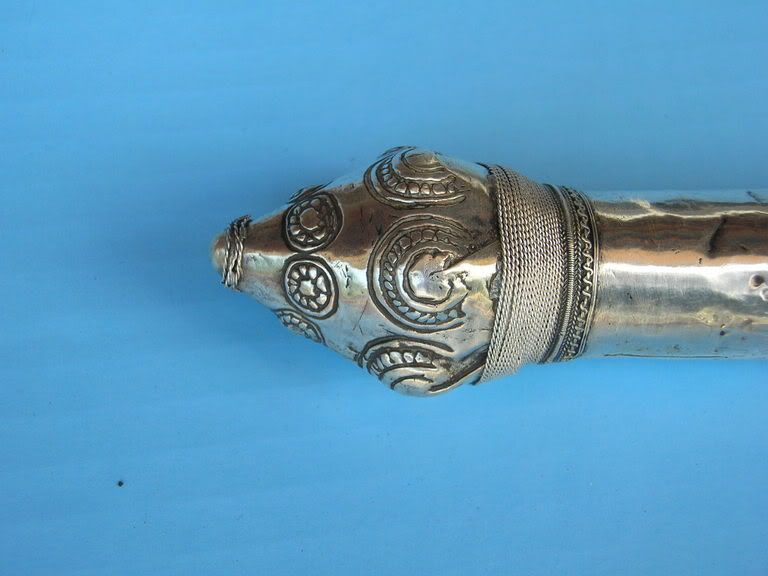 Jose fabricated a completely new scabbard mouth and chape from silver.  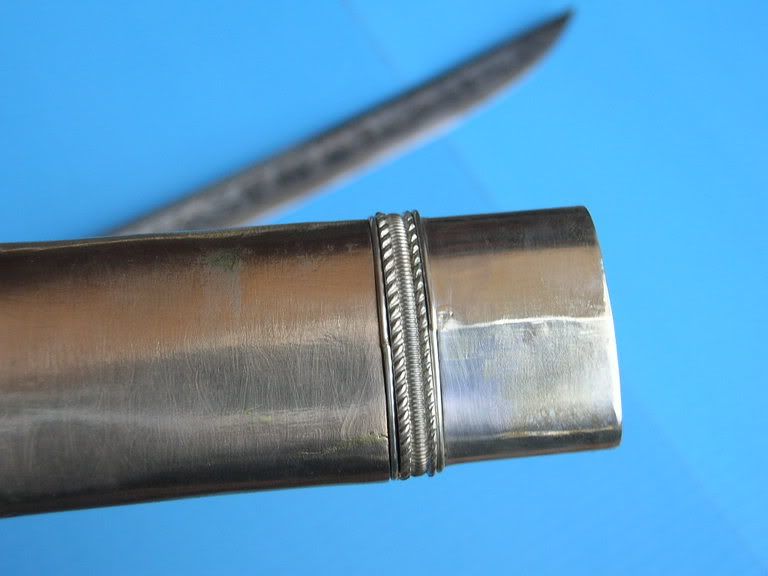 A small section of the gorgeous silver koftgari on the blade. 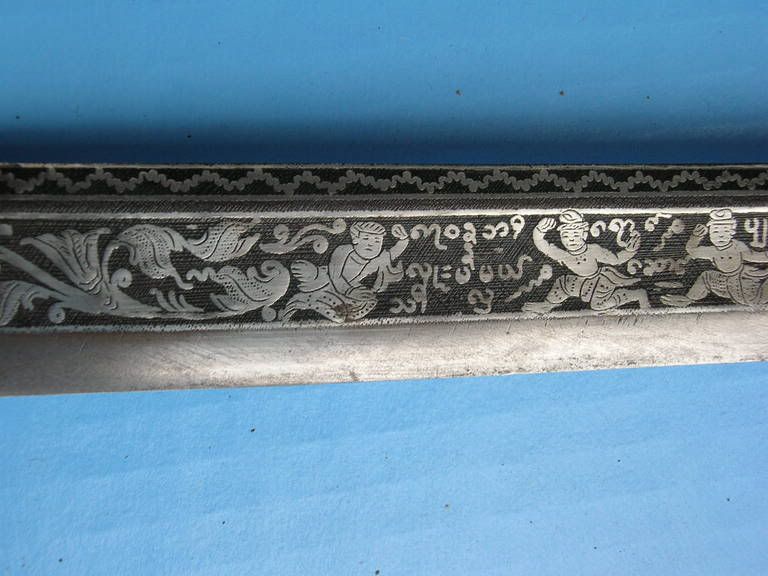 The majority of the scabbard covering is a brass alloy (perhaps low-content silver Jose?) that polished up very nicely. Almost looks silver. Jose replaced the missing or disintigrating resin dividing bands between the scabbard sections with lovely silver bands. I am extremely pleased with this restoration, and forever grateful to Jose for his craftsmanship and hard work. 
|
|
|

|
|
|
#2 |
|
Member
Join Date: Dec 2004
Location: VISAYAS and MINDANAO
Posts: 169
|
WOW!!! That is one BEAUTIFUL dha!
Andrew, congratulations on that dha and good call by having Battara do restoration work on it. Jose is truly an artisan in all respects. |
|
|

|
|
|
#3 |
|
Member
Join Date: Nov 2004
Location: USA
Posts: 1,725
|
Thanks, Zel.

|
|
|

|
|
|
#4 |
|
Member
Join Date: Mar 2005
Location: Macau
Posts: 294
|
Beautiful blade and beautiful restoration work by José.
Congratulations Andrew  Antonio |
|
|

|
|
|
#5 |
|
Member
Join Date: Dec 2004
Location: Virginia
Posts: 520
|
Wow that looks great Andrew. Now we need to find someone to translate the story. I have been told they are often Buddist parables
|
|
|

|
|
|
#6 | |
|
Member
Join Date: Nov 2004
Location: USA
Posts: 1,725
|
Quote:
 I hope when Jose has some time, he'll stop by this thread and provide some description of the process. |
|
|
|

|
|
|
#7 | |
|
Member
Join Date: Nov 2004
Location: USA
Posts: 1,725
|
Quote:
I'm dying to have these swords translated! I have also read (can't recall where, specifically) that the "stories" are Buddhist. The panels at the forte may be much more interesting. I'll post pix of the knife you sold me for comparison, as the story that appears there is different than any I've personally seen. It actually depicts a forge. |
|
|
|

|
|
|
#8 |
|
Vikingsword Staff
Join Date: Dec 2004
Location: The Aussie Bush
Posts: 4,527
|
Excellent dha Andrew and, as usual, Battara has done a great job with the repairs/restoration work. I'll be interested to hear the translation of the "story."
The silver inlay work on the blade is very crisp on this example, a feature that I think is a guide to the level of skill of the silver smith and the overall quality of the sword. Ian. |
|
|

|
|
|
#9 |
|
EAAF Staff
Join Date: Dec 2004
Location: Louisville, KY
Posts: 7,346
|
Thank you so much for your comments.
 I'm so glad that Andrew is pleased with the results. When I got the piece, the very top was squashed and coming off, so I had to replace it with a dome shape I made and placed wire I twisted (like me I'm so glad that Andrew is pleased with the results. When I got the piece, the very top was squashed and coming off, so I had to replace it with a dome shape I made and placed wire I twisted (like me  ) around the bottom it, the same wire that I used to cover the base of the pommel which was a 1/4-1/2 inche of lead. The silver collars of the top and bottom of the ivory part were dented and I had to get these out as well. Speaking of the ivory part, this was covered with adhesive that was difficult to take off also. ) around the bottom it, the same wire that I used to cover the base of the pommel which was a 1/4-1/2 inche of lead. The silver collars of the top and bottom of the ivory part were dented and I had to get these out as well. Speaking of the ivory part, this was covered with adhesive that was difficult to take off also. Andrew asked me to darken the background of the blade to bring out the silver. I tried a blackening solution, but that worked for a while until it began to later rust out the background metal. So I turned to something completely different - permanent India ink. No rust there.  Ah the scabbard.......This was fun.......the bands were darkened brass and very rough on the surface. Interspaced between each band, as Andrew stated, were bands of brass wire held in place by pitch. I took all of that off and, per Andrew, replaced them with silver wire. I then reshaped the large brass bands, cleaned them and polished them (again per Andrew) and made a silver top and bottom chape. The original top chape had a tin flat plate that was uneven and warped. I just soft soldered a new silver plate to the top chape band (because I made it fit too well). In the middle of all of this Andrew sent me a dha dagger that was the "little Bro" of the dha sword and I did the same type of stuff to it to match. I did, however, have to pull off the upside down ivory handle and reattach it. All of this took a while and I was a little rushed because I wanted to get this all to Andrew for Timonium (and get some money to bring to the show  ). But all in all, no one was destroyed in the making of this product. ). But all in all, no one was destroyed in the making of this product.  Oh, BTW - I did try to get pictures in process, but my el cheapo camera did not take pictures worth printing. Oh, BTW - I did try to get pictures in process, but my el cheapo camera did not take pictures worth printing.  Next on Santa's list: a digital camera and enter the 21st century. Next on Santa's list: a digital camera and enter the 21st century. 
|
|
|

|
|
|
#10 |
|
Member
Join Date: Nov 2004
Location: USA
Posts: 1,725
|
India ink! I had forgotten about that bit.
 I'll post up pix of the small, matching dha later tonight. I'll post up pix of the small, matching dha later tonight.Jose, is it common for brass to polish up so white, or does this have a high white-metal content to it (tin?)? The fault failing to get pre-restoration photos is mine: I can't believe I didn't snap some before sending it to you.  Maybe we can work out a trade for a digi-cam on the next project..... Maybe we can work out a trade for a digi-cam on the next project..... 
|
|
|

|
|
|
#11 |
|
Vikingsword Staff
Join Date: Dec 2004
Location: The Aussie Bush
Posts: 4,527
|
Silver over brass is also possible, with some thinning of the top silver layer. I've noticed this before on Burmese swords and scabbards.
Ian. |
|
|

|
|
|
#12 |
|
EAAF Staff
Join Date: Dec 2004
Location: Louisville, KY
Posts: 7,346
|
In this case the bands are brass, perhaps with more tin and less copper. I tested the bands in the process. No silver content in them what-so-ever, not even an over lay. Yes, some brass shines up very near white metal when the copper content is lower. I would place these as inbetween white metal and yellow brass. The more copper content, the redder and/or yellower it becomes. Sometimes it is hard to tell the difference at first glance between newely shined whiter brass, silver, and white metal.
|
|
|

|
|
|
#13 | |
|
Member
Join Date: Dec 2004
Posts: 987
|
Quote:
The stories are scenes from Buddhist Jattaka (stories of the life of Gautama Buddha, and I think of his previous lives as well), as well as stories from Burmese folklore (like the swordsmith one). I am pursuing leads for translation in Burma. Slowly, unfortunately. |
|
|
|

|
|
|
#14 |
|
Member
Join Date: Dec 2004
Location: Greenville, NC
Posts: 1,854
|
I remember seeing this in March. Gorgeous piece, and beautifully restored!!
|
|
|

|
|
|
#15 |
|
Member
Join Date: Dec 2004
Posts: 987
|
I found the story of the Burmese "patron saint" of smiths. I had a few details wrong (the king married into the smith's family, not the other way around), but here it is.
“Maung Tin De, the legendary hero of the Popa myth, is represented as a blacksmith of prodigious strength. His date by the chronicles is the fourth century A.D. The son of a blacksmith, Maung Tin De could wield in his right hand a twenty-five viss hammer, and a twenty-viss hammer in his left: and under his blows the anvil roared like thunder and all the people around were struck with panic. His great power was a source of fear to the King of Tagaung where he lived, who to secure himself married his beautiful sister Saw Me Ya, and afterwards seized by treachery the smith, whose funeral pyre was shared by his sister: the pair of them thereafter became the most powerful Nats, the Mahagiri Maung Hnama Daw of Popa.” Bell, E.N., A Monograph on Iron and Steel Work in Burma, Superintendent of Printing, Rangoon (1907), p. 2. Mt. Popa is an extinct volcano closeby the old Burmese capital Pagan, and is the legendary birthplace of smithing (as an early source of iron ore). A viss is a unit of measure used throughout SEA, but I can't remember its equivalent in grams or ounces. Tagoung was a pre-Pagan Burmese kingdom, and Nats are guardian spirits pre-dating Buddhism in Burma, and still greatly revered. I am willing to wager that it is the story of Maung Tin De that is on your dha, Andrew. |
|
|

|
|
|
#16 |
|
Member
Join Date: Nov 2004
Location: USA
Posts: 1,725
|
Thanks for the information, Mark.
 Here's a picture of the actual knife, a close-up of the forge, and the scene from the opposite side (note the leaf-bladed sword): 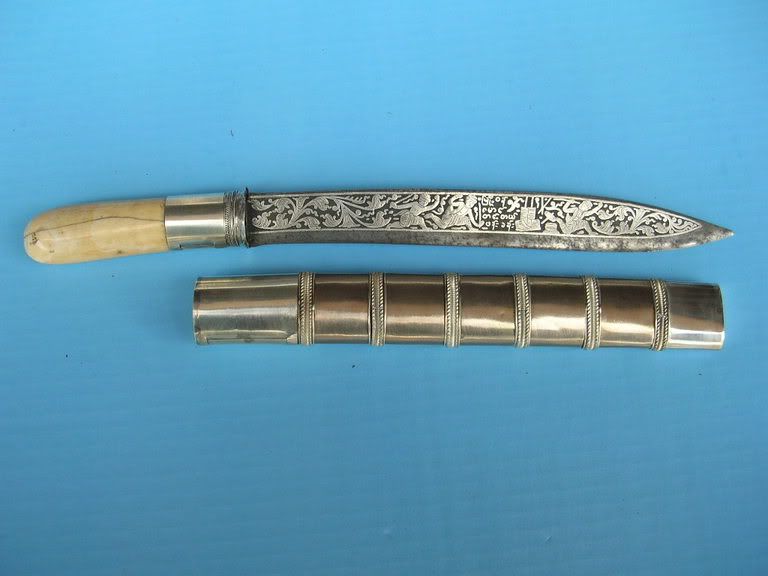 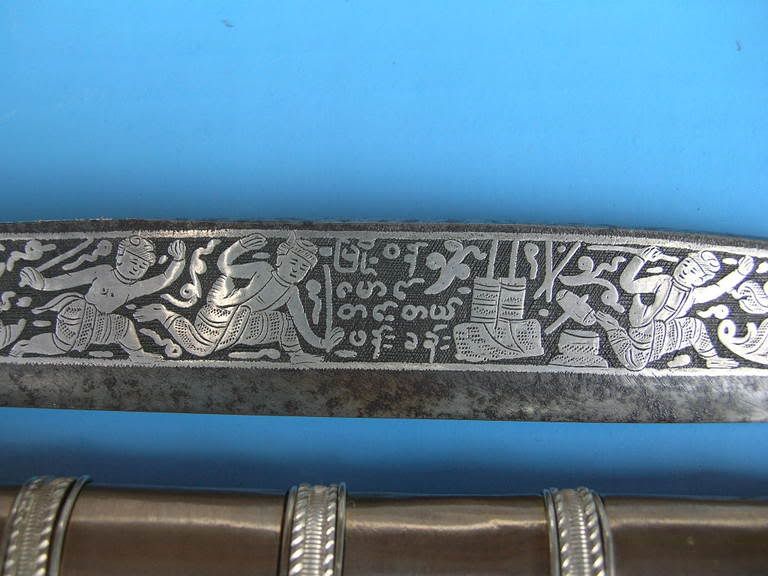 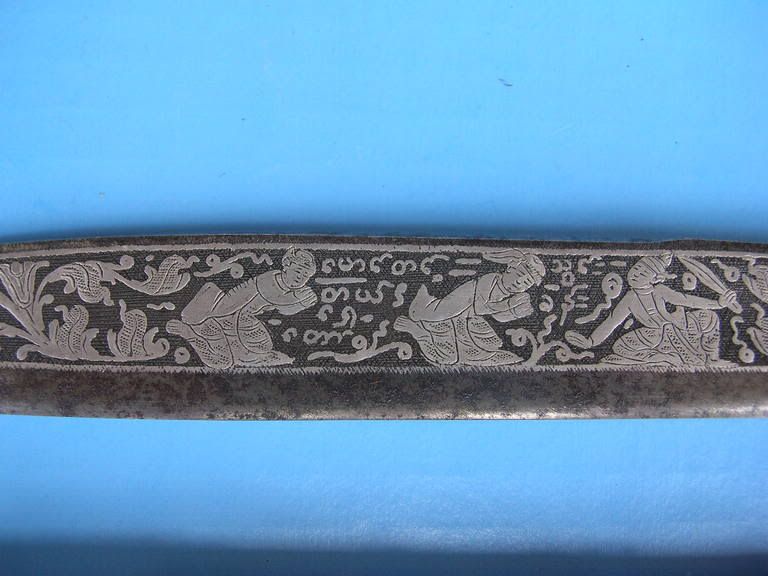 This knife was a perfect match for the larger sword, so I had Jose restore it in the same way. The similarities between these two, as well as some others in my collection and several others I've handled and looked in photos leads me to believe they all come from the same maker or facility. |
|
|

|
|
|
#17 |
|
EAAF Staff
Join Date: Dec 2004
Location: Louisville, KY
Posts: 7,346
|
Seeing this lovely puppy again reminded me of something else I had to do. I had to make another silver sleeve on the hilt because the original one was disintigrating (verythin silver
 ). On this one I also ground and polished the rough brass on the scabbard and made a silver top and bottom along with silver bands inbetween the brass sections. Looks better now that the hilt is upside right. ). On this one I also ground and polished the rough brass on the scabbard and made a silver top and bottom along with silver bands inbetween the brass sections. Looks better now that the hilt is upside right.  Had some trouble with the brass in that inbetween the brass were brass wire/pitch and the brass sections were veryuneven. Had some trouble with the brass in that inbetween the brass were brass wire/pitch and the brass sections were veryuneven.  I had to cut them straight and even cut a small section of wood on the scabbard to make everything fit. Lot of work but well worth it for both. I had to cut them straight and even cut a small section of wood on the scabbard to make everything fit. Lot of work but well worth it for both. 
|
|
|

|
|
|
#18 |
|
Member
Join Date: Dec 2004
Location: Europe
Posts: 2,718
|
Hi Andrew,
The sword itself is a pleasure to look at, and the restoration very professional done – congratulation. One gets the feeling that the smith, having finished the sword, made the knife out of the rest of the iron  . .
|
|
|

|
 |
|
|